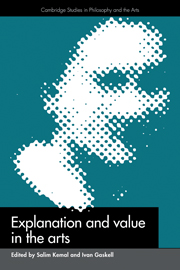Book contents
- Frontmatter
- Contents
- List of contributors
- Editors' acknowledgments
- 1 Interests, values, and explanations
- 2 Fiction and reality in painting
- 3 Franz Kafka: the necessity for a philosophical interpretation of his work
- 4 On relocating ethical criticism
- 5 Explanation and value: what makes the visual arts so different, so appealing?
- 6 Is art history?
- 7 Objectivity and valuation in contemporary art history
- 8 Fullness and parsimony: notes on creativity in the arts
- 9 Principles of a sociology of cultural works
- 10 Althusser and ideological criticism of the arts
- 11 Film, rhetoric, and ideology
- Index
8 - Fullness and parsimony: notes on creativity in the arts
Published online by Cambridge University Press: 24 February 2010
- Frontmatter
- Contents
- List of contributors
- Editors' acknowledgments
- 1 Interests, values, and explanations
- 2 Fiction and reality in painting
- 3 Franz Kafka: the necessity for a philosophical interpretation of his work
- 4 On relocating ethical criticism
- 5 Explanation and value: what makes the visual arts so different, so appealing?
- 6 Is art history?
- 7 Objectivity and valuation in contemporary art history
- 8 Fullness and parsimony: notes on creativity in the arts
- 9 Principles of a sociology of cultural works
- 10 Althusser and ideological criticism of the arts
- 11 Film, rhetoric, and ideology
- Index
Summary
INTRODUCTION
Creativity – the ability to fashion objects that are valuable for their beauty, truth or usefulness – is an elusive phenomenon. Like time or power, it is easier to recognize than to characterize. This essay offers some notes on creativity that are, I hope, more than random yet certainly less than systematic. The main topic is creativity in the arts. Here, I draw not on expertise or even a modicum of knowledge in aesthetics, but on my experience as a lay reader, spectator or listener. Some art forms I know better than others, notably the early-nineteenth-century novel (Stendhal and Jane Austen) and American jazz and films between 1935 and 1940, but even of those I am only an amateur, in both senses of the word. My interests and loves may give what I have to say a bias towards classical art forms that put a premium on order and well-roundedness. There is not much I can do about that, except to warn the reader.
Whatever specialized knowledge I bring to the topic derives from other sources. Some years ago I wrote a book on technical change, a phenomenon that turns out to bear some similarity to that of artistic innovation. In particular, the idea that good works of art can be seen as local maxima derives from this earlier work. Later, work on Marx led me to consider the notion of self-realization, a notion that is multiply central in the analysis offered here. Finally, as a writer myself, I have reflected on the processes that go into the writing of a chapter such as this one.
- Type
- Chapter
- Information
- Explanation and Value in the Arts , pp. 146 - 172Publisher: Cambridge University PressPrint publication year: 1993
- 3
- Cited by



